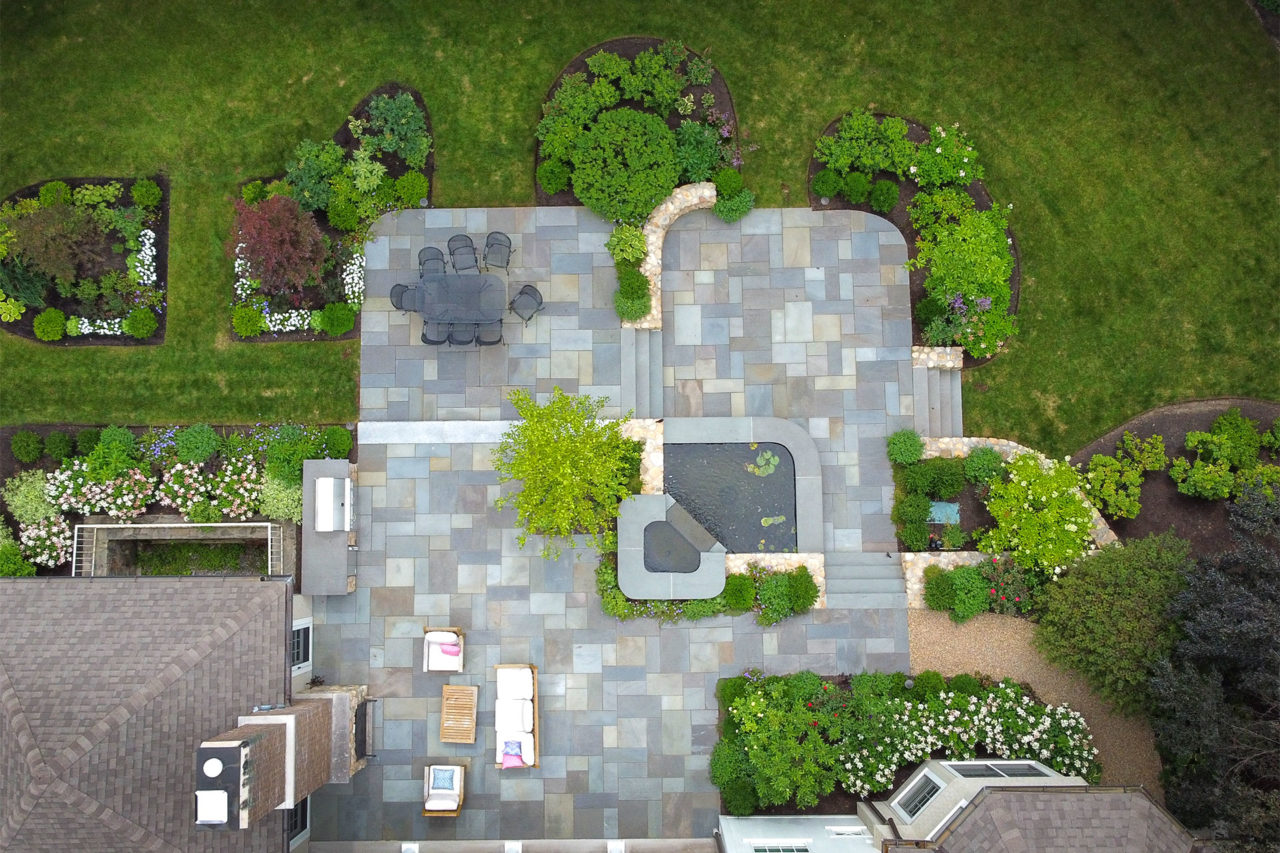If you’re planning to enhance your outdoor space in Boston or the surrounding suburbs, there’s more to consider than just plants and patio materials. From fences and retaining walls to outdoor kitchens and drainage changes, many landscape projects in Massachusetts require permits—and skipping them can lead to fines, delays, or forced removal.
Key Takeaways
- Many landscaping upgrades — from fences and retaining walls to drainage changes — trigger local permits in Boston-area towns.
- Skipping the permitting process can lead to delays, fines, or forced removal.
- You’ll get a step-by-step roadmap: when to engage zoning, conservation, historical review, and how to work with your town’s permitting office.
In this guide, we’ll walk you through the essential steps and legal considerations for starting a landscape project in the Greater Boston area. Whether you live in Cambridge, Brookline, Newton, or nearby towns, staying compliant with local and state regulations can save you time, money, and stress.
Why Permits Are Often Required
Landscaping permits aren’t just bureaucratic red tape—they’re designed to protect your property, your neighbors, and the surrounding environment. Local governments use them to enforce zoning rules, building codes, conservation laws, and public safety requirements.
For example, installing a fence over a certain height might obstruct visibility on a corner lot, while altering your yard’s slope could redirect stormwater runoff to a neighbor’s basement. Permitting ensures these risks are reviewed before construction begins.
As Massachusetts land use attorney John Smolak explains:
“Even small landscaping changes can have ripple effects. The permitting process isn’t just about following rules—it’s about planning responsibly for the long term.”
Common Landscape Projects That Trigger Permits
It’s not always obvious which projects require approval. While planting annuals or spreading mulch generally won’t raise flags, larger or more permanent upgrades often do. In most towns, you’ll likely need permits or official review for things like fences taller than six feet, decks or patios with footings, retaining walls over four feet high, and any outdoor structure that includes plumbing or electrical work.
Installing a driveway or making changes to your curb cut? That’s almost always regulated. So is removing trees in environmentally sensitive areas, working near wetlands, or changing how water drains from your property.
Before you begin any major project, it’s smart to check with your local building department—even if the work seems straightforward.
Start with Zoning and Conservation Regulations
Your first step should be to understand your property’s zoning designation. Zoning laws determine what kinds of structures and features you’re allowed to build, how close they can be to your property lines, and what activities are permitted in your area.
You can usually find zoning maps and guidance on your city or town’s planning department website. For example, Boston homeowners can consult the Zoning Viewer to determine their district and applicable rules. Newton, Brookline, Cambridge, and most surrounding towns offer similar tools.
If your property is located near wetlands, a river, or in a floodplain, you’ll also need to consider Massachusetts conservation laws. Under the state’s Wetlands Protection Act, any work within 100 feet of a protected area may require special approval. Many towns—such as Lexington or Concord—go even further with stricter local ordinances.
To find out if your landscape project might be impacted by conservation rules, contact your town’s Conservation Commission or consult the MassDEP Wetlands Permitting Guide.
Building Permits and Planning Reviews
Not every outdoor project requires a building permit, but many do. If your design involves excavation, hardscaping, plumbing, or structures like pergolas, fire pits, or sheds with foundations, expect to fill out a permit application.
This process often includes submitting a site plan, construction details, contractor information, and an application fee. Depending on your municipality, the review can take a few days to several weeks. In Boston, for instance, homeowners can apply online through the City of Boston Permit Portal.
It’s also worth noting that many towns require permits for grading or altering existing drainage patterns—especially if you’re working with more than 5000 square feet of disturbed area, as is the case in Newton under their Stormwater Ordinance.
What If You’re in a Historic District?
Properties located in designated historic districts—such as Beacon Hill, parts of Salem, or Lexington Center—are subject to an extra layer of regulation. Any visible exterior work, including landscaping, must be approved by your local Historical Commission. Even something as simple as replacing a fence or adding exterior lighting could require a review process and hearing.
The goal is to preserve the visual character of historically significant neighborhoods, and this often means strict guidelines around materials, colors, and design.
If your property is governed by a Homeowners Association (HOA), you’ll also want to check their landscaping bylaws. These rules vary widely but often dictate fence styles, planting restrictions, and even acceptable colors for outdoor structures.
Key Considerations for Tree Removal and Drainage
Tree protection has become a growing priority in Massachusetts, especially in urban areas. Cities like Cambridge and Brookline have ordinances that require permits to remove large trees on private property. In Cambridge, for example, any tree greater than eight inches in diameter may be protected under the city’s Tree Protection Ordinance.
In Boston, trees planted in the public right-of-way or on city property are protected by law, and any proposed removal or pruning requires approval from the Parks and Recreation Department.
Drainage is another area where homeowners should proceed carefully. Changing the slope of your land, adding impervious surfaces, or connecting to the storm drain system can all affect downstream properties. Many towns now require a drainage plan or stormwater review for larger projects to prevent erosion and flooding.
What About Retaining Walls, Lighting, or Stone Walls?
Retaining walls taller than four feet often require structural review and permitting. These walls can affect soil stability, water runoff, and neighboring properties, so cities want to ensure they are safely engineered.
Outdoor lighting is another often-overlooked element. While string lights or solar path lights are usually fine, installing hardwired fixtures—especially floodlights—must comply with municipal codes designed to reduce light pollution and protect neighboring homes from glare.
If your property features old stone walls, take caution. In many rural towns like Weston or Dover, roadside stone walls are protected under scenic road bylaws. Moving or altering them could trigger a public hearing or permit requirement.
How Long Does the Permit Process Take?
Project timelines can vary depending on the size and complexity of your landscape design. Simple permits may be approved in a week or two, while projects involving conservation, zoning appeals, or multiple departments may take two to three months.
Spring and early summer are the busiest times for building and planning offices, so be sure to start the process early. Your landscape contractor or designer should be familiar with local permitting timelines, but ultimately, the responsibility for compliance rests with you as the homeowner.
Permit fees also vary widely. Minor projects may cost under $100 to permit, while larger projects involving engineering review or public hearings could cost several hundred dollars or more.
Resources for Homeowners
To help you get started, here are some direct links to municipal permit pages and zoning tools for the Greater Boston area:
- Boston: Inspectional Services Department
- Brookline: Building and Conservation Info
- Newton: Permits and Stormwater Requirements
- Cambridge: Department of Public Works
- Arlington: Permits and Conservation Guidelines
Additionally, the Massachusetts Association of Conservation Commissions (MACC) is a helpful resource for understanding local wetland bylaws and conservation procedures.
Final Thoughts
If you’re planning a landscape upgrade in the Boston area, don’t wait until after you’ve hired a crew to think about permits. Starting early and engaging with your local planning department—or working with a landscape firm that handles permitting—can make your project smoother and more successful.
As Chris Tracey of the Ecological Landscape Alliance wisely puts it:
“Permits are not the enemy. They’re part of responsible stewardship. Getting it right upfront protects your investment and helps your project integrate seamlessly into the community and the environment.”
Need Help With Your Project?
At a Blade of Grass, we specialize in creating elegant, sustainable outdoor spaces that are not only beautiful, but fully compliant with local regulations. Our team understands the ins and outs of permitting across Boston and the surrounding suburbs—and we handle it all so you don’t have to.
From initial concept to final planting, we make sure your project meets all zoning, conservation, and building standards. Contact us today to schedule a consultation and take the first step toward a worry-free transformation of your property.


